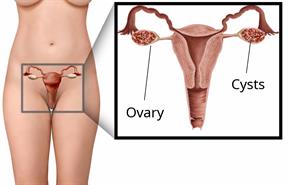Polycystic Ovary Syndrome

Polycystic ovarian syndrome (PCOS) is a common hormonal disorder among women of reproductive age. In most women with PCOS, small fluid-filled sacs (cysts) grow on the ovaries. PCOS can cause problems with menstrual periods and make it hard to get and stay pregnant. If this condition is not treated, it can lead to serious health problems, such as diabetes and heart disease.
What are the causes?
The cause of this condition is not known. It may be due to certain factors, such as:
Irregular menstrual cycle.
High levels of certain hormones.
Problems with the hormone that helps to control blood sugar (insulin).
Certain genes.
What increases the risk?
You are more likely to develop this condition if you:
Have a family history of PCOS or type 2 diabetes.
Are overweight, eat unhealthy foods, and are not active. These factors may cause problems with blood sugar control, which can contribute to PCOS or PCOS symptoms.
What are the signs or symptoms?
Symptoms of this condition include:
Ovarian cysts and sometimes pelvic pain.
Menstrual periods that are not regular or are too heavy.
Inability to get or stay pregnant.
Increased growth of hair on the face, chest, stomach, back, thumbs, thighs, or toes.
Acne or oily skin. Acne may develop during adulthood, and it may not get better with treatment.
Weight gain or obesity.
Patches of thickened and dark brown or black skin on the neck, arms, breasts, or thighs.
How is this diagnosed?
This condition is diagnosed based on:
How is this treated?
There is no cure for this condition, but treatment can help to manage symptoms and prevent more health problems from developing. Treatment varies depending on your symptoms and if you want to have a baby or if you need birth control.
Treatment may include:
Making nutrition and lifestyle changes.
Taking the progesterone hormone to start a menstrual period.
Taking birth control pills to help you have regular menstrual periods.
- Taking medicines such as:
Having surgery in severe cases. This may involve making small holes in one or both of your ovaries. This decreases the amount of testosterone that your body makes.
Follow these instructions at home:
-
Take over-the-counter and prescription medicines only as told by your health care provider.
-
Follow a healthy meal plan that includes lean proteins, complex carbohydrates, fresh fruits and vegetables, low-fat dairy products, healthy fats, and fiber.
-
If you are overweight, lose weight as told by your health care provider. Your health care provider can determine how much weight loss is best for you and can help you lose weight safely.
-
Keep all follow-up visits. This is important.
Contact a health care provider if:
Summary
-
Polycystic ovarian syndrome (PCOS) is a common hormonal disorder among women of reproductive age.
-
PCOS can cause problems with menstrual periods and make it hard to get and stay pregnant.
-
If this condition is not treated, it can lead to serious health problems, such as diabetes and heart disease.
-
There is no cure for this condition, but treatment can help to manage symptoms and prevent more health problems from developing.
This information is not intended to replace advice given to you by your health care provider. Make sure you discuss any questions you have with your health care provider.
